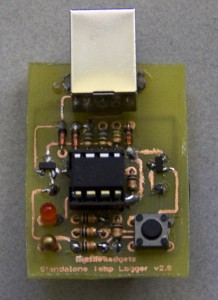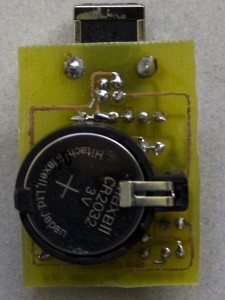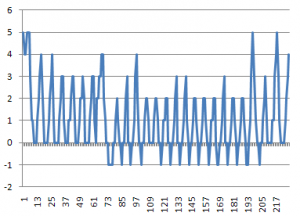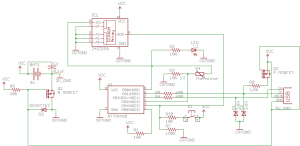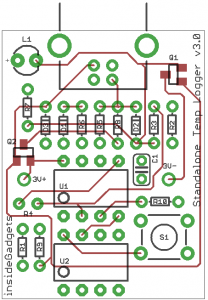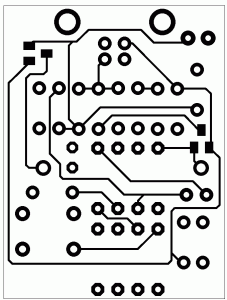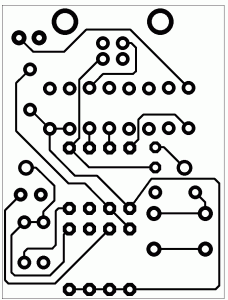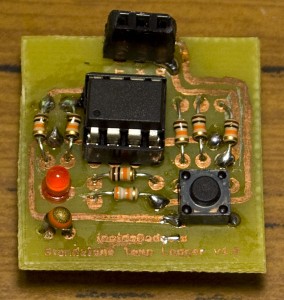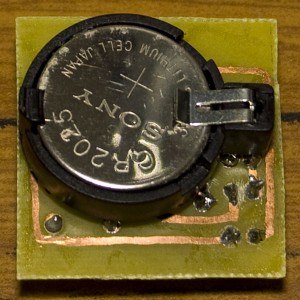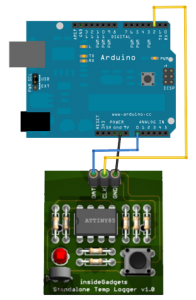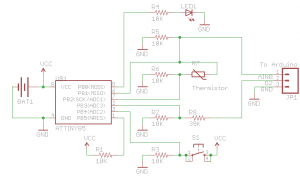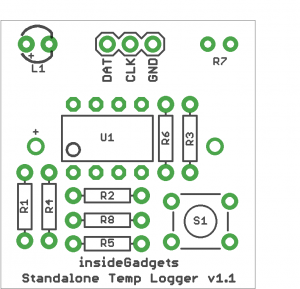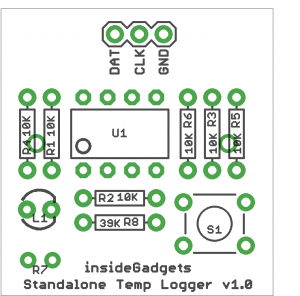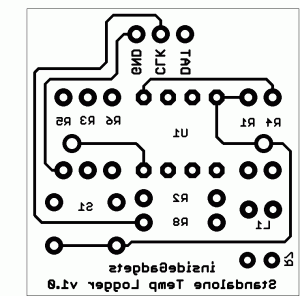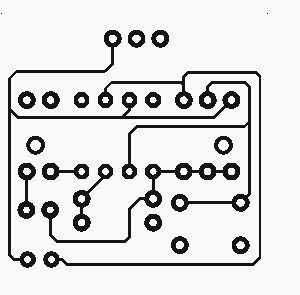Standalone Temperature Logger
Mar 4th, 2011 by Alex
The Standalone Temperature Logger has been merged with the Standalone Voltage Logger to give the Standalone Temperature/Voltage Logger available in kit form.
A standalone temperature logger in a small compact form factor with minimal parts using the ATtiny85 and an I2C external EEPROM powered by a 3V coin cell. Extract the data logged by connecting to your PC using a USB cable. The standalone temperature logger uses V-USB – http://www.obdev.at/vusb/. There are 2 versions, v3.0 & v2.0 which uses USB and v1.0 which connects to an Arduino to transfer the data.
You can view how I designed and built it by following the posts found here – https://www.insidegadgets.com/tag/satl/page/2/
Features
– Low power consumption, at least 1 year battery life
– Uses an external I2C EEPROM, supports up to 512Kbit which is 65536 recordings
– 12 logging delay times available (28secs, 1min, 5mins, 10mins, 15mins, 30mins, 1hr, 2hrs, 4hrs, 8hrs, 12hrs, 24hrs)
– Easily transfer the logged data to your PC via USB
Specifications
PCB Board: 37mm x 28mm
Voltage: 2.7V to 5.5V
Current used when sleeping: 5uA
Current used when logging – Watchdog sleep routine: 0.3mA for 30ms approximately every 4 seconds
Current used when logging – Thermistor on and write to EEPROM: 3mA (max) for 50ms
Accuracy of thermistor: within 5% -/+ (between -40C to 25C is 1.25C -/+, 25C to 50C is 1.5C -/+, 50C – 70C+ is 1.9C -/+)
Accuracy of timer: within 10% -/+
Resolution of temperature: 0.65C (rounded up or down in 0.5 – 1C increments)
Operating temperature: -40C to 70C
Download
v3.0b (16 May 2012) – Download
– Reverted calibrateOscillator function back to the default as my patch wasn’t needed
– After a USB transfer is complete, made OSCCAL go back to the factory default settings in steps of 32
v3.0a (2 May 2012) – Download
– Corrected EEPROM size test code to work with 32Kbit EEPROMs
v3.0 (4 March 2012) – Download
– Added external I2C EEPROM support with automatic EEPROM size checking
– Updated 10K resistor divider to 1% tolerance
– Added 28 seconds to delay options available
– Updated temperature resolution to be 0.65C which is rounded up or down in 0.5 – 1C increments thanks to the suggestion made by tytower
v2.2 (23 December 2011) – Download
– Updated Thermistor function to use the full Steinhart–Hart equation and the Vishay 10K coefficients
v2.1 (31 October 2011) – Download
– Updated R7 resistor for button from 10k to 100k to save power (0.27mA saved)
– Removed need for Timer0, millis and delay_at_1mhz. Instead uses the watchdog timer to save power (1mA saved)
v2.0a (28 October 2011) – Download
– Highly recommend disabling BOD as is a chance that the BOD will kick in at ~2.98V depending
on what the MCU is doing.
v2.0 (10 July 2011) – Download
– Now uses V-USB to transfer data to the PC directly without needing an Arduino)
Sample Data
Y axis is the temperature and X axis is each interval.
Outside (under shelter) – 15 minute intervals
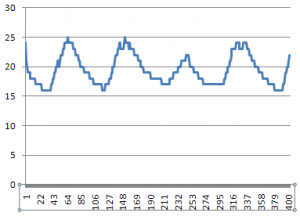
Outside (in daylight) – 5 minute intervals
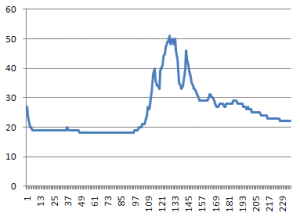
Car glove box – 5 minute intervals
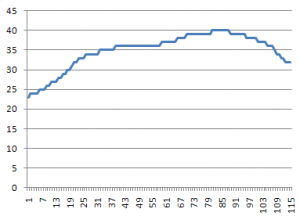
Programming the ATtiny85
To program the ATtiny85 and fuse bits we use AVRDUDE
- Change the fuse bits so the ATtiny85 uses 16MHz PLL and divide clock by 8
avrdude -p ATtiny85 -c usbtiny -U lfuse:w:0x61:m -U hfuse:w:0xdf:m -U efuse:w:0xff:m2.7V Brown-out Detection is optional (-U hfuse:w:0xdd:m) and is only recommended for CR2032 batteries that are new or near new condition. When batteries drop to ~2.95V there may be issues when powering up the ATtiny85. - Upload the main.hex file
avrdude -p ATtiny85 -c usbtiny -U flash:w:main.hex
How to use
Inserting the EEPROM
- You should only remove or insert the EEPROM when the battery has been removed.
First time use
- Insert the EEPROM (you should only remove or insert the EEPROM when the battery has been removed).
- Insert the battery.
- The LED will either blink which indiciates there is a EEPROM present or it will stay on for 2 seconds which means no EEPROM was found.The number on blinks corresponds to the EEPROM size it found as below:
——————————————————————
| Blinks | EEPROM size | Max recordings |
| 1 | 1Kbit | 128 |
| 2 | 2Kbit | 256 |
| 3 | 4Kbit | 512 |
| 4 | 8Kbit | 1024 |
| 5 | 16Kbit | 2048 |
| 6 | 32Kbit | 4096 |
| 7 | 64Kbit | 8192 |
| 8 | 128Kbit | 16384 |
| 9 | 256Kbit | 32768 |
| 10 | 512Kbit | 65536 |
—————————————————————— - Ready to use
Changing logging time intervals
- Hold the button down for 2 seconds, the LED will stay on for 2 seconds to confirm you are changing the logging time.
- Configure the logging time interval by pressing the button the amount of times shown below.
Please wait for the LED to light up to confirm each button press.
1 button press = 28 seconds
2 button presses = 1 minute
3 button presses = 5 minutes
4 button presses = 10 minutes
5 button presses = 15 minutes
6 button presses = 30 minutes
7 button presses = 1 hour
8 button presses = 2 hours
9 button presses = 4 hours
10 button presses = 8 hours
11 button presses = 12 hours
12 button presses = 24 hours - Hold the button down for 1 second to confirm your logging time interval, the LED will blink three times to confirm.
(If the LED stays on for 2 seconds too many button presses were made, please repeat step 2)
Start temperature logging
- Press the button 3 times within 2 seconds to activate the temperature logging. The LED will blink three times to confirm. The LED will blink very quickly every time it logs temperature.If the LED stays on for 2 seconds this means that no external EEPROM was found.
Exit temperature logging
- Press the button once and the LED will blink 2 times.
Transfer the data to the PC
- Plug the USB cable into the Standalone Temperature Logger
- Open Notepad
- Press the button once. The LED will stay on until the data transfer is complete.
- Unplug the USB cableIf you remove the USB cable mid-way through the data transfer and find the LED is still lit, please remove and re-insert the battery.
Test the USB communication
- Program the ATtiny85
- Follow “Transfer the data to the PC” steps
- The number “124.5” should be printed as many times as the “Max recordings” shown in the table allows for your EEPROM. If no EEPROM is inserted, it will print “124.5” until disconnected.
Build your own
Parts Required
– Standalone Temperature Logger v3.0 PCB board
– ATtiny85 20MHz DIP8 (1) – ATTINY85-20PU – [U1]
– N Channel Mosfet 2.3V[Threshold Vgs Max] SOT-23 (1) – 2N7002K – [Q1]
– P Channel Mosfet -1.7V[Threshold Vgs Typ] SOT23 (1) – BSS84 – [Q2]
– 10K Resistor 1/8W (5) – [R1, R2, R3, R9, R10]
– 10K Resistor 1/8W 1% (1) – [R3]
– 150K Resistor 1/8W (1) – [R7]
– 1.5K Resistor 1/8W (1) – [R8]
– 68R Resistor 1/8W (2) – [R5, R6]
– 10K Thermistor (1) – NTCLE100E3103JB0 – [R4]
– Zener Diode 3.6V 1/2W DO-35 (2) – 1N5227B – [D1, D2]
– Schottky Diode 400mV[VF Max] DO-35 (1) – BAT42 – [D3]
– 3mm Red LED (1) – MCL514SRD – [L1]
– 4.3mm Tactile switch (1) – MJTP1230 – [S1]
– 8 pin IC socket (1)
– 3V CR2032 coin cell (1)
– Coin cell battery holder (1)
– USB Type B Receptacle (1) – USB-B-S-RA – [USB]
Schematic
PCB Guide
PCB Ready for etching
Version 1.0 (Needs an Arduino to extract the data from)
A standalone temperature logger in a small compact form factor with minimal parts using the ATtiny85V and powered by a 3V coin cell. Extract the data logged by connecting up to an Arduino.
Features
– Low power consumption, at least half a year battery life
– Store up to 511 values of temperature
– 11 logging delay times available (1min, 5mins, 10mins, 15mins, 30mins, 1hr, 2hrs, 4hrs, 8hrs, 12hrs, 24hrs)
– Transfer the logged data to the Arduino
Specifications
Voltage: 1.8 to 5.5 Volts
Current used when sleeping/waiting for input: 0.02mA
Accuracy of logging timer: within 10% -/+
Operating temperature: -40C to 70C
Requirements
Arduino Duemilanove or Uno
Download
v1.1 – Updated PCB to v1.1 – Download
v1.0 – Initial Release – Download
How to use
Changing logging time
- Hold the button down for 2 seconds, the LED will stay one for 2 seconds to confirm you are changing the logging time.
- Configure the delay time by pressing the button.
1 button press = 1min
2 button presses = 5mins
3 button presses = 10mins
4 button presses = 15mins
5 button presses = 30mins
6 button presses = 1hr
7 button presses = 2hrs
8 button presses = 4hrs
9 button presses = 8hrs
10 button presses = 12hrs
11 button presses = 24hrs - Hold the button down to confirm your logging time, the LED will blink three times.
Start temperature logging
- Press the button 3 times in 1.5 seconds to activate the temperature logging. The LED will blink three times to confirm.
Exit temperature logging
- Press the button once and the LED will blink 2 times.
Transfer the data to the Arduino
- Upload the “Standalone_Temperature_Logger_Arduino_Reader_Side.pde” to the Arduino
- Connect the 3 wires (DAT, CLK and GND) and then press the button once. The LED will blink twice if it’s still logging the temperature.
- Start the Arduino software and open the serial monitor, the text “Ready” should appear.
- Both the LED and Arduino LED’s will stay lit when the transfer is in progress and the temperature will be printed in the serial monitor.
- The end of the temperature values is shown by the text “End” appearing.
How to upload the program to the ATtiny85
- Copy the “attiny45_85” folder to “C:\Program Files\arduino-0021\hardware”.
- Open the Arduino software and open the sketch named “ArduinoISP”.
- Upload this to the Arduino board.
- Connect the Arduino to the ATtiny85 as shown.
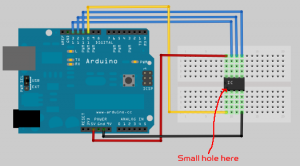
- In the Arduino software, select Tools -> Board -> ATtiny85.
- Open the “Standalone_Temperature_Logger_ATtiny85_Side.pde” sketch and upload it. The LED of the Arduino will blink whilst uploading.
- Once uploading is done, unplug the Arduino, remove the connections to the ATtiny85 and insert the ATtiny85 chip to the Standalone Temperature Logger board.
Build your own
PCB Revisions
v1.1 – Re-arranged board so that soldering the battery isn’t difficult any more
v1.0 – Initial Release
Parts required
U1 – ATtiny85V (1)
R1, R2, R3, R4, R5, R6 – 10K Resistor 1/8W (6)
R7 – 10K Thermistor (1)
R8 – 39K Resistor 1/8W (1)
S1 – Tactile switch (1)
LED1 – 3mm Red LED (1)
8 pin IC socket
3 pin female header
3V CR2032 coin cell
Coin cell battery holder
PCB Ready for printing
Version 1.1 (untested)
30mm x 28.4mm
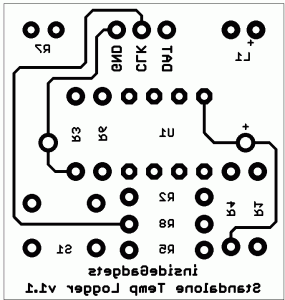
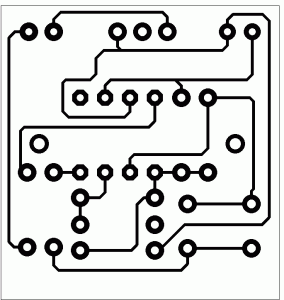

This work is licensed under a Creative Commons Attribution-NonCommercial 3.0 Unported License.
